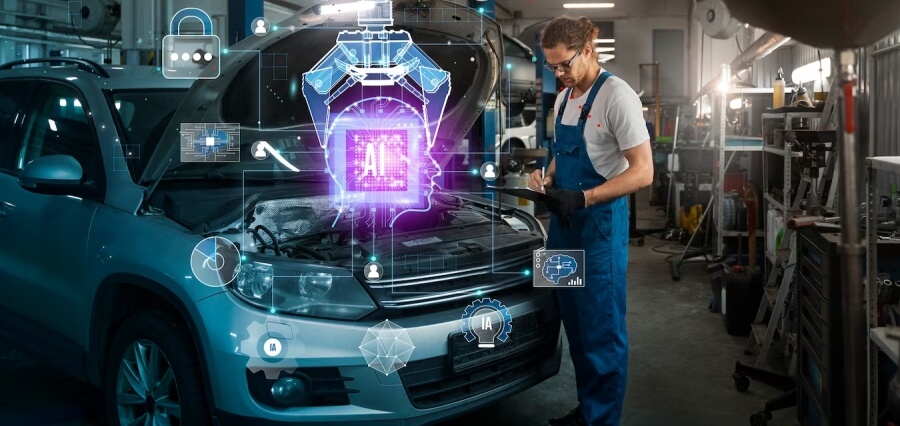In the age of rapid technological advancements, Artificial Intelligence (AI) has emerged as a game-changer in-vehicle monitoring and management. The fusion of AI with modern technologies has revolutionized how we track and oversee vehicles, offering an array of benefits, from improved safety and efficiency to cost savings.
In this blog post, we will explore the construction of AI vehicle monitoring systems using contemporary technologies and the transformative impact these systems have on the automotive industry.
The Advantages of AI in Vehicle Monitoring
Before diving into the technological aspects, it’s important to recognize the significant advantages AI brings to vehicle monitoring:
Real-Time Tracking: AI-powered systems enable real-time tracking and monitoring of vehicles. This real-time data provides fleet managers with insights into vehicle location, speed, and status, enhancing decision-making.
Predictive Maintenance: AI can analyze vehicle data to predict when maintenance is needed. This proactive approach minimizes downtime and reduces repair costs.
Fuel Efficiency: AI-driven algorithms can optimize routes and driving behavior, resulting in reduced fuel consumption and lower environmental impact.
Safety Enhancement: AI systems can monitor driver behavior, identify potential risks, and provide alerts to prevent accidents, making the roads safer for everyone.
Building AI Vehicle Monitoring Systems
To construct effective AI vehicle monitoring systems, modern technologies play a crucial role. Here are the key components:
IoT (Internet of Things) Devices
IoT devices, such as GPS trackers, sensors, and cameras, are the eyes and ears of AI vehicle monitoring systems. These devices collect a wealth of data, including vehicle location, speed, engine performance, and driver behavior.
Data Analytics
Once the data is collected from IoT devices, advanced data analytics techniques come into play. AI algorithms process and analyze the data to extract valuable insights. These insights can range from real-time tracking information to predictive maintenance recommendations.
Machine Learning
Machine learning algorithms are the brains behind AI vehicle monitoring systems. They can identify patterns, anomalies, and trends in the data. For instance, machine learning models can predict when a vehicle is likely to require maintenance or raise alerts for risky driving behavior.
Cloud Computing
Cloud computing provides the necessary infrastructure for storing and processing vast amounts of data. It enables real-time data transmission and remote access, allowing fleet managers to monitor vehicles from anywhere.
Mobile Applications
Mobile applications offer an intuitive interface for fleet managers and drivers to access the AI vehicle monitoring system. These apps provide real-time alerts, location tracking, and data visualization, making it easy to stay informed and make informed decisions.
AI Vehicle Monitoring Technologies in Action
Let’s take a closer look at how these technologies work together to create a seamless AI vehicle monitoring system:
Real-Time Tracking
IoT devices, like GPS trackers, continuously send location data to the cloud. Machine learning algorithms analyze this data to provide real-time vehicle tracking. Fleet managers can monitor the position of their entire fleet in real-time, enabling them to optimize routes and make quick decisions to address delays or emergencies.
Predictive Maintenance
Sensors within vehicles collect data on engine performance, temperature, and other critical factors. Machine learning models can analyze this data to predict when maintenance is required. By identifying issues before they become critical, companies can reduce downtime and costly repairs.
AI vehicle monitoring systems use cameras and sensors to track driver behavior. Machine learning models can recognize patterns associated with risky behavior, such as speeding, harsh braking, or distracted driving. When such behavior is detected, the system can send alerts to the driver or fleet manager, ultimately improving safety.
Fuel Efficiency
Machine learning algorithms can optimize routes based on historical traffic data, weather conditions, and vehicle load. This results in fuel-efficient routes, reducing both fuel consumption and the environmental impact of vehicle operations.
Remote Access and Alerts
Mobile applications allow fleet managers and drivers to access the AI vehicle monitoring system from their smartphones. The apps provide real-time alerts for issues like engine problems, maintenance reminders, and driver behavior violations. This immediate feedback enables timely action and improves overall fleet efficiency.
Challenges and Considerations
While AI vehicle monitoring systems offer numerous benefits, they also come with challenges and considerations:
Data Privacy: Collecting data from vehicles raises concerns about data privacy. It’s essential to have strict data protection measures in place to safeguard sensitive information.
Security: AI systems can be vulnerable to cyberattacks. Robust security measures are crucial to prevent unauthorized access or data breaches.
Cost of Implementation: The initial cost of implementing AI vehicle monitoring systems can be substantial. Companies must consider the return on investment over the long term.
Driver Acceptance: Drivers may initially be hesitant about constant monitoring. Companies must address these concerns and communicate the benefits of AI systems.
Conclusion
With the assistance of ai development services providers, the integration of AI and modern technologies into vehicle monitoring is revolutionizing the automotive industry. AI systems offer real-time tracking, predictive maintenance, enhanced safety, and improved fuel efficiency, resulting in cost savings and a reduced environmental footprint.
However, to harness the full potential of these systems, companies must address data privacy, security, and cost considerations. By building AI vehicle monitoring systems that balance technological innovation with responsible implementation, businesses can drive their fleets more efficiently and safely into the future.


